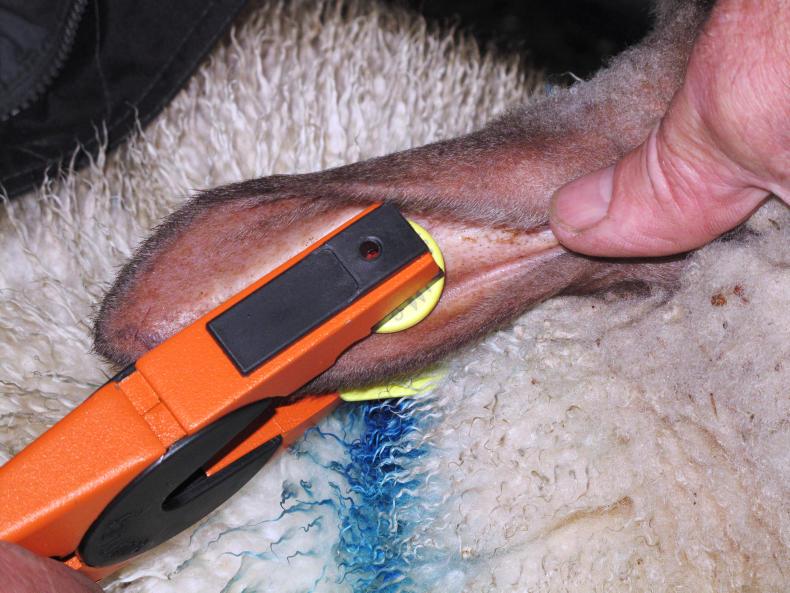Tagging can be a tricky proposition, with lambs often hard to handle and startled once tagged.
Incorrect tagging of lambs can increase the risk of infection, particularly during current humid conditions, and increase the risk of tag losses. Buyers of ewe lambs with breeding potential are particularly conscious of the way in which tags are applied and do not want to be in a position of having to replace tags or address ear infections.

Care should be taken to avoid piercing the cartilage, with tags applied between these areas.
The advice for applying button tags is to insert the tag midway in the height of the ear, taking care to avoid cartilage (which can be seen on the underside of the ear) and at a distance of about one-third of the way along the animal’s ear, measuring from the head out. This distance may need to be extended in breeds with thicker ears as there should be some room for the tag to rotate and for air to circulate around the site of application.
Many tag manufactures released wraparound tags on to the market since mandatory electronic identification was introduced across the entire flock over 12 months ago.
Tag manufacturers remain keen to advise farmers who may be new to applying wraparound tags to take care as to the way they are applied, particularly in young sheep that are not going directly for slaughter. They advise applying the tag in a manner that leaves room between the edge of the ear and the tag. This is to ensure tags do not become too tight as animals mature and ears grow.

Where applying wrap around tags on young animals it is advised to leave some room for ear growth.
The general recommendation is to allow 4mm to 5mm for ear growth and, again, more may be necessary for breeds with large or thick ears. The advice is to apply wraparound tags at the top of the ear and, similar to a button tag, about a third of the distance out from the head, taking care not to pierce cartilage. The male part which pierces the ear should be applied on the outer part, leaving less risk for tags to get caught.

Tags should be stored in a manner that prevents soiling as this will increase the risk of infections. / David Ruffles
Where at all possible, tag when ears are dry and ensure the sheep is securely restrained. Ensure that equipment is clean and that tags are stored and handled in a manner that prevents soiling. Some farmers find that spraying a simple disinfectant on the animal’s ear and the part of the ear tag that pierces the skin of the ear helps.
Tagging can be a tricky proposition, with lambs often hard to handle and startled once tagged.
Incorrect tagging of lambs can increase the risk of infection, particularly during current humid conditions, and increase the risk of tag losses. Buyers of ewe lambs with breeding potential are particularly conscious of the way in which tags are applied and do not want to be in a position of having to replace tags or address ear infections.

Care should be taken to avoid piercing the cartilage, with tags applied between these areas.
The advice for applying button tags is to insert the tag midway in the height of the ear, taking care to avoid cartilage (which can be seen on the underside of the ear) and at a distance of about one-third of the way along the animal’s ear, measuring from the head out. This distance may need to be extended in breeds with thicker ears as there should be some room for the tag to rotate and for air to circulate around the site of application.
Many tag manufactures released wraparound tags on to the market since mandatory electronic identification was introduced across the entire flock over 12 months ago.
Tag manufacturers remain keen to advise farmers who may be new to applying wraparound tags to take care as to the way they are applied, particularly in young sheep that are not going directly for slaughter. They advise applying the tag in a manner that leaves room between the edge of the ear and the tag. This is to ensure tags do not become too tight as animals mature and ears grow.

Where applying wrap around tags on young animals it is advised to leave some room for ear growth.
The general recommendation is to allow 4mm to 5mm for ear growth and, again, more may be necessary for breeds with large or thick ears. The advice is to apply wraparound tags at the top of the ear and, similar to a button tag, about a third of the distance out from the head, taking care not to pierce cartilage. The male part which pierces the ear should be applied on the outer part, leaving less risk for tags to get caught.

Tags should be stored in a manner that prevents soiling as this will increase the risk of infections. / David Ruffles
Where at all possible, tag when ears are dry and ensure the sheep is securely restrained. Ensure that equipment is clean and that tags are stored and handled in a manner that prevents soiling. Some farmers find that spraying a simple disinfectant on the animal’s ear and the part of the ear tag that pierces the skin of the ear helps.









 This is a subscriber-only article
This is a subscriber-only article









SHARING OPTIONS: